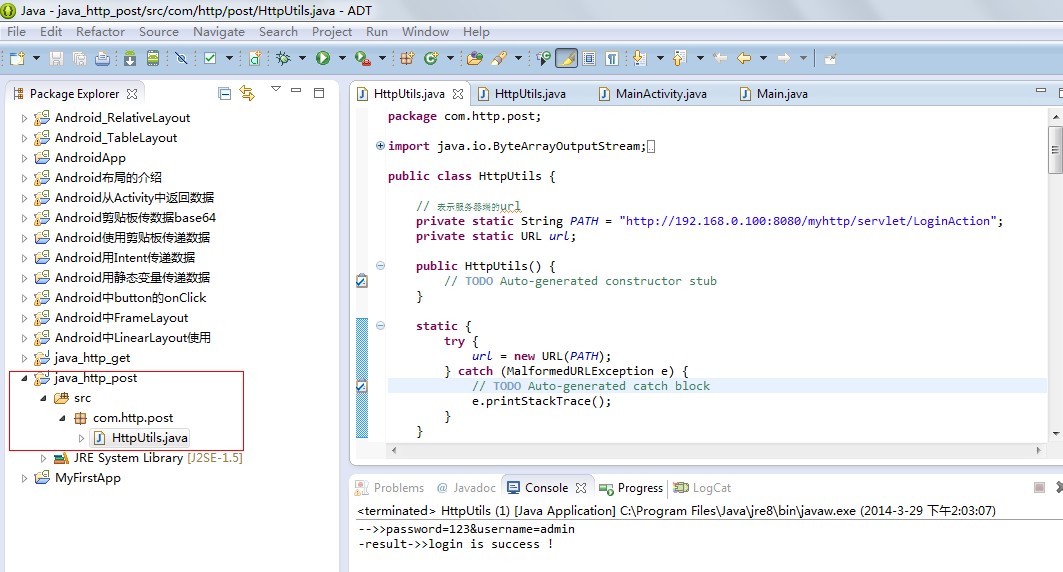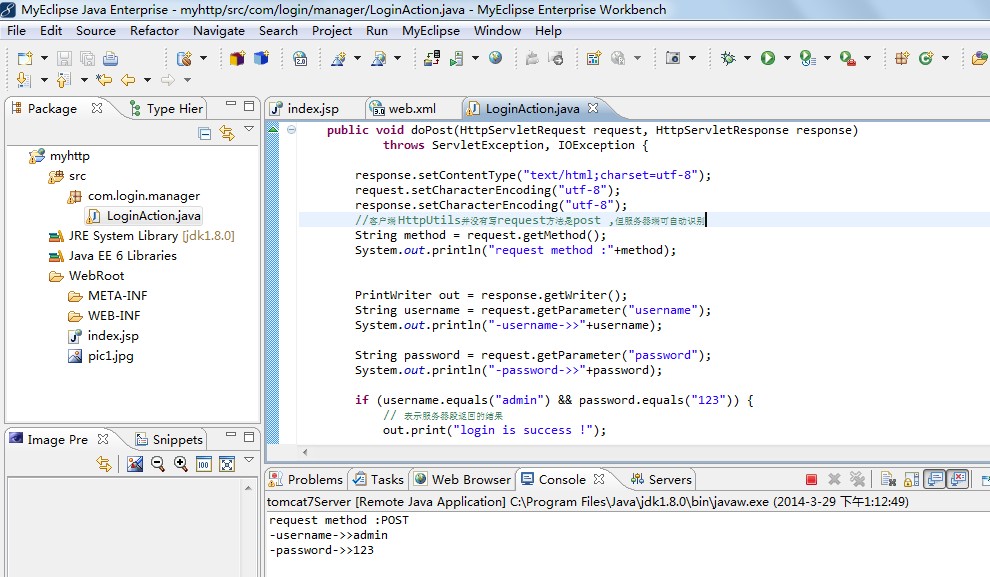Http使用post方式提交資料(使用java標準介面)
本文內容:使用java標準介面,實現http用post方式提交資料。
-------------------------------------------------------------------------------------------------------------
程式組成部分:
1.客戶端用eclipse HttpUtils.java 標準java介面,實現http用post方式提交資料。 (用post方式提交 username 和 password)
2.伺服器端用myeclipse+tomcat 對客戶端請求進行相應。(若使用者名稱密碼正確,則返回字串"login is success !" ,不正確則返回字串“login is fail !”)
重點注意點:
1. public static String sendPostMessage(Map<String,String> params , String encode)
目的: 在客戶端向伺服器端傳送 資料 params , 最終獲取從伺服器返回的輸入流,最終將該輸入流轉換成字串。注意使用標準java介面如何實現http的post請求,成功與伺服器連線,並且獲得從伺服器端響應返回的資料。
2. public String String changInputStream(InputStream inputStream , String encode)
目的: 將一個輸入流按照指定編碼方式轉變成一個字串。(本例中是指,將從伺服器端返回的輸入流InputStream轉變成一個字串String,編碼方式是encode方式)
3. Map<String ,String> 的例項化方法及迭代方法
Map 的例項化方法:
Map<String, String> params = new HashMap<String, String>();
params.put("username", "admin");
params.put("password", "123");
Map 的迭代方法:
StringBuffer stringBuffer = new StringBuffer();
for (Map.Entry<String, String> entry : params.entrySet()) {
try {
stringBuffer
.append(entry.getKey())
.append("=")
.append(URLEncoder.encode(entry.getValue(), encode))
.append("&");
} catch (UnsupportedEncodingException e) {
// TODO Auto-generated catch block
e.printStackTrace();
}
// 刪掉最後一個 & 字元
stringBuffer.deleteCharAt(stringBuffer.length() - 1);
----------------------------------------------------------------------------------------------------------------
程式思路:
1. 客戶端建立http連結httpURLConnection,使用OutputStream向伺服器傳入資料
2. 獲得從伺服器端返回的輸入流InputStream
3. 將InputStream轉換成字串String
----------------------------------------------------------------------------------------------------------------
程式執行效果:
1.客戶端執行效果
2. 伺服器端執行結果
關鍵程式碼:
1. 客戶端 HttpUtils.java
package com.http.post;
import java.io.ByteArrayOutputStream;
import java.io.IOException;
import java.io.InputStream;
import java.io.OutputStream;
import java.io.UnsupportedEncodingException;
import java.net.HttpURLConnection;
import java.net.MalformedURLException;
import java.net.URL;
import java.net.URLEncoder;
import java.util.HashMap;
import java.util.Map;
public class HttpUtils {
// 表示伺服器端的url
private static String PATH = "http://192.168.0.100:8080/myhttp/servlet/LoginAction";
private static URL url;
public HttpUtils() {
// TODO Auto-generated constructor stub
}
static {
try {
url = new URL(PATH);
} catch (MalformedURLException e) {
// TODO Auto-generated catch block
e.printStackTrace();
}
}
/*
* params 填寫的URL的引數 encode 位元組編碼
*/
public static String sendPostMessage(Map<String, String> params,
String encode) {
StringBuffer stringBuffer = new StringBuffer();
if (params != null && !params.isEmpty()) {
for (Map.Entry<String, String> entry : params.entrySet()) {
try {
stringBuffer
.append(entry.getKey())
.append("=")
.append(URLEncoder.encode(entry.getValue(), encode))
.append("&");
} catch (UnsupportedEncodingException e) {
// TODO Auto-generated catch block
e.printStackTrace();
}
}
// 刪掉最後一個 & 字元
stringBuffer.deleteCharAt(stringBuffer.length() - 1);
System.out.println("-->>" + stringBuffer.toString());
try {
HttpURLConnection httpURLConnection = (HttpURLConnection) url
.openConnection();
httpURLConnection.setConnectTimeout(3000);
httpURLConnection.setDoInput(true);// 從伺服器獲取資料
httpURLConnection.setDoOutput(true);// 向伺服器寫入資料
// 獲得上傳資訊的位元組大小及長度
byte[] mydata = stringBuffer.toString().getBytes();
// 設定請求體的型別
httpURLConnection.setRequestProperty("Content-Type",
"application/x-www-form-urlencoded");
httpURLConnection.setRequestProperty("Content-Lenth",
String.valueOf(mydata.length));
// 獲得輸出流,向伺服器輸出資料
OutputStream outputStream = (OutputStream) httpURLConnection
.getOutputStream();
outputStream.write(mydata);
// 獲得伺服器響應的結果和狀態碼
int responseCode = httpURLConnection.getResponseCode();
if (responseCode == 200) {
// 獲得輸入流,從伺服器端獲得資料
InputStream inputStream = (InputStream) httpURLConnection
.getInputStream();
return (changeInputStream(inputStream, encode));
}
} catch (IOException e) {
// TODO Auto-generated catch block
e.printStackTrace();
}
}
return "";
}
/*
* // 把從輸入流InputStream按指定編碼格式encode變成字串String
*/
public static String changeInputStream(InputStream inputStream,
String encode) {
// ByteArrayOutputStream 一般叫做記憶體流
ByteArrayOutputStream byteArrayOutputStream = new ByteArrayOutputStream();
byte[] data = new byte[1024];
int len = 0;
String result = "";
if (inputStream != null) {
try {
while ((len = inputStream.read(data)) != -1) {
byteArrayOutputStream.write(data, 0, len);
}
result = new String(byteArrayOutputStream.toByteArray(), encode);
} catch (IOException e) {
// TODO Auto-generated catch block
e.printStackTrace();
}
}
return result;
}
/**
* @param args
*/
public static void main(String[] args) {
// TODO Auto-generated method stub
Map<String, String> params = new HashMap<String, String>();
params.put("username", "admin");
params.put("password", "123");
String result = sendPostMessage(params, "utf-8");
System.out.println("-result->>" + result);
}
}
伺服器端servlet: LoginAction.java
package com.login.manager;
import java.io.IOException;
import java.io.PrintWriter;
import javax.servlet.ServletException;
import javax.servlet.http.HttpServlet;
import javax.servlet.http.HttpServletRequest;
import javax.servlet.http.HttpServletResponse;
public class LoginAction extends HttpServlet {
/**
* Constructor of the object.
*/
public LoginAction() {
super();
}
/**
* Destruction of the servlet. <br>
*/
public void destroy() {
super.destroy(); // Just puts "destroy" string in log
// Put your code here
}
/**
* The doGet method of the servlet. <br>
*
* This method is called when a form has its tag value method equals to get.
*
* @param request
* the request send by the client to the server
* @param response
* the response send by the server to the client
* @throws ServletException
* if an error occurred
* @throws IOException
* if an error occurred
*/
public void doGet(HttpServletRequest request, HttpServletResponse response)
throws ServletException, IOException {
this.doPost(request, response);
}
/**
* The doPost method of the servlet. <br>
*
* This method is called when a form has its tag value method equals to
* post.
*
* @param request
* the request send by the client to the server
* @param response
* the response send by the server to the client
* @throws ServletException
* if an error occurred
* @throws IOException
* if an error occurred
*/
public void doPost(HttpServletRequest request, HttpServletResponse response)
throws ServletException, IOException {
response.setContentType("text/html;charset=utf-8");
request.setCharacterEncoding("utf-8");
response.setCharacterEncoding("utf-8");
//客戶端 HttpUtils並沒有寫request方法是post ,但伺服器端可自動識別
String method = request.getMethod();
System.out.println("request method :"+method);
PrintWriter out = response.getWriter();
String username = request.getParameter("username");
System.out.println("-username->>"+username);
String password = request.getParameter("password");
System.out.println("-password->>"+password);
if (username.equals("admin") && password.equals("123")) {
// 表示伺服器段返回的結果
out.print("login is success !");
} else {
out.print("login is fail !");
}
out.flush();
out.close();
}
/**
* Initialization of the servlet. <br>
*
* @throws ServletException
* if an error occurs
*/
public void init() throws ServletException {
// Put your code here
}
}


